Avoid Tragedy: Check Your Yard for These Potentially Fatal Growths
They may frequent your yard and are one of the leading causes of pet poisoning every year, yet it's nearly impossible to tell deadly varieties from innocent ones. If ingested, emergency care is essential to save your pet's life. Just be sure you bring this to the vet with you.

STORY AT-A-GLANCE
- Mushroom poisoning in pets presents a special problem for guardians and veterinarians because it’s nearly impossible to tell the difference between toxic and nontoxic varieties
- Symptoms of mushroom toxicity are dependent on the species of mushroom, the specific toxin(s) involved, and the individual pet’s susceptibility to those toxins
- Treatment of mushroom poisoning is focused on decontamination and managing clinical symptoms as they arise. It is often difficult to predict the outcome of treatment unless the mushroom can be accurately identified
- If you know or suspect your pet has ingested a mushroom, seek help immediately, and if possible, collect any uneaten mushrooms and/or vomit and feces samples to take with you to the vet or emergency animal hospital
Editor's Note: This article is a reprint. It was originally published June 20, 2015.
Mushroom intoxication in pets is probably underestimated, according to some experts, even though it ranks near the top of the list of pet poisonings each year.
Mushrooms present a special problem for pet parents because unless you're a mushroom expert (called a mycologist), it's next to impossible to tell the difference between toxic and nontoxic varieties.
According to Dr. Ahna Brutlag, assistant director of Veterinary Services at the national Pet Poison Helpline, separating toxic from nontoxic mushrooms is "the million dollar question."1
"Mushrooms are notoriously hard to identify," she explains. "However innocent looking a mushroom appears, some of them can be life threatening."
For example, the notoriously toxic "false morel" mushroom looks very much like the edible, much sought-after morel mushroom favored by gourmet cooks.
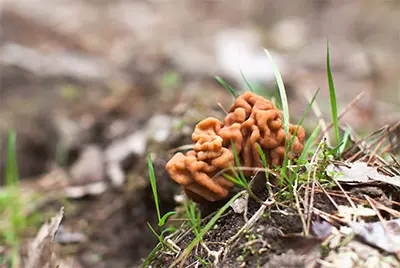
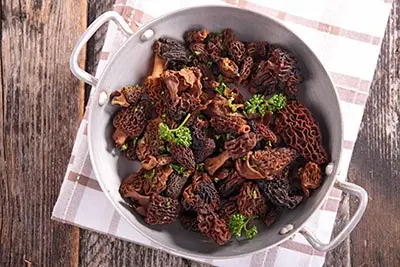
There are several thousand species of mushrooms in existence, but relatively few are thought to be toxic. The majority of fatal poisonings in pets involve mushrooms from the genera Amanita, Galerina, and Lepiota.
The amanita mushroom, for example, is found in Europe, Asia and North America. It has as many as seven varieties of colors and shapes, which increases the difficulty of correctly identifying it. According to Dr. Brutlag, eating just one of these mushrooms can be deadly.
Symptoms of Mushroom Poisoning
Clinical signs of mushroom poisoning depend on the species of mushroom ingested, the specific toxin the mushroom contains, and the individual animal's susceptibility.
Generally speaking, mushroom poisoning has four distinct clinical syndromes, according to Dr. Charlotte Means of the ASPCA National Animal Poison Control Center:2
- Gastrointestinal (GI) irritation — This is the most common symptom and is rarely serious enough to be fatal. Vomiting and diarrhea typically occur within about six hours of ingestion. GI upset runs its course in about 24 hours and requires minimal veterinary care.
- GI upset plus muscarinic effects — Muscarinic effects include excessive drooling and tear production, which are also symptoms of carbamate and organophosphate insecticide poisoning. Pupils may be small and constricted, but the most serious sign is a significantly slowed heartbeat.
This clinical syndrome usually occurs within six hours of mushroom ingestion and almost always requires veterinary care. Species of mushrooms that commonly cause this syndrome are from the genera Inocybe and Clitocybe.
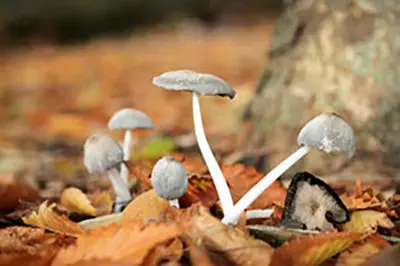
Inocybe spp.
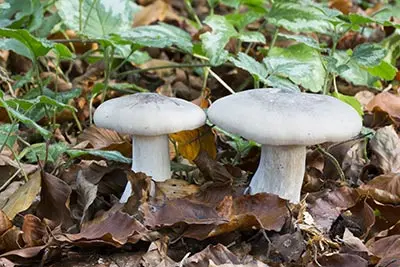
Clitocybe nebularis - GI upset, muscarinic effects, depression, and lethargy — This clinical syndrome is characterized by severe abdominal pain and vomiting. There can also be jaundice (a yellowing of the whites of the eyes and mucous membranes), bleeding disorders and seizures as a result of liver damage. These symptoms occur between 6 and 20 hours after mushroom ingestion, and without prompt, aggressive treatment, they are often fatal.
The death cap mushroom (Amanita phalloides) is most often the culprit in these cases, along with the false morel (Gyromitra esculenta) pictured above, and the Galerina.
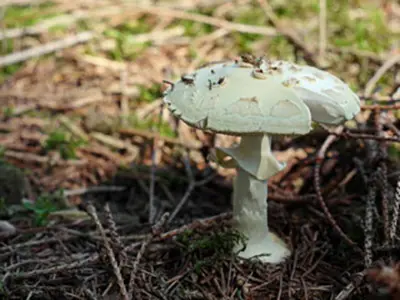
Amanita phalloides (death cap mushroom)
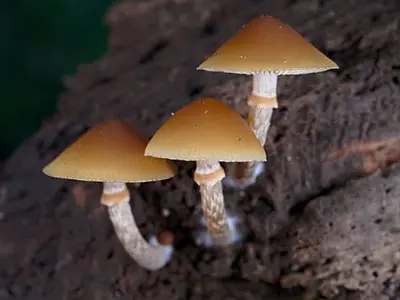
Galerina - Hallucinogenic syndrome — Illegal "street" mushrooms commonly known as magic mushrooms, blue legs, or liberty caps, cause this syndrome. These are nontoxic mushrooms (the kind sold in grocery stores) that have been tainted with LSD or other illicit drugs.
Pets typically find these mushrooms in someone's indoor stash, not in the yard or the woods. Symptoms of magic mushroom ingestion can include restlessness, hallucinations, "air biting," extreme depression, staggering, muscle tremors, seizures, and coma. If you suspect your pet has ingested this type of mushroom, you should get him to your veterinarian or an emergency animal clinic immediately.
Treatment for Mushroom Intoxication
Treatment for mushroom poisoning depends on the symptoms, and is focused on stabilizing your pet, decontamination, and managing any clinical signs that may develop.
Decontamination includes inducing vomiting to remove any remnants of the mushroom from the stomach. The next step is typically administration of activated charcoal to absorb any remaining toxins.
If your pet continues to show signs of toxicity, the veterinary staff will try to identify the type of mushroom ingested by contacting a mycologist in the area. According to Dr. Brutlag, it's often impossible to predict the outcome for your pet until the mushroom is identified.
That's why it's important to bring any uneaten mushrooms with you to the vet or emergency animal clinic. Wrap them in a paper towel and place them in a paper (not plastic) bag. If there will be any delay between wrapping the mushrooms and leaving for your vet's office, place the mushrooms in the refrigerator and mark the bag "Do not eat!"
The symptoms and organs affected depends on what type of mushroom your pet consumed, however, many holistic vets and human MDs have had excellent results decreasing toxicosis with homeopathic remedies (the remedy selected based on the animal's symptoms).3
Preventing Mushroom Poisoning in Your Pet
Mushrooms in yards (yours and your neighbors') should be removed promptly before neighborhood pets have a chance to notice them.
As a general rule, veterinarians and pet poison experts consider all mushroom ingestions in pets toxic unless a quick and accurate identification of the mushroom can be made.
If you know or suspect your pet has eaten a mushroom, immediately contact your veterinarian, the nearest emergency animal clinic, or the 24/7 Pet Poison Helpline at 855-764-7661. If your pet throws up or poops, collect a sample, place it in a plastic bag, and bring it with you.











